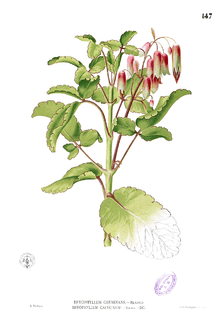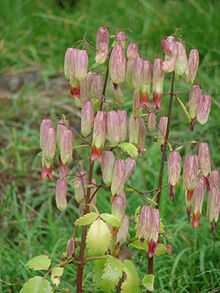Bryophyllum pinnatum
| Bryophyllum pinnatum | |
|---|---|
 | |
| Vegetative reproduction in the "Air Plant", Bryophyllum pinnatum | |
| Scientific classification | |
| Kingdom: | Plantae |
| (unranked): | Angiosperms |
| (unranked): | Eudicots |
| (unranked): | Core eudicots |
| Order: | Saxifragales |
| Family: | Crassulaceae |
| Genus: | Bryophyllum |
| Species: | B. pinnatum |
| Binomial name | |
| Bryophyllum pinnatum (Lam.) Oken | |
| Synonyms[1] | |
| |


Bryophyllum pinnatum, also known as the Air Plant, Life Plant, Miracle Leaf, and Goethe Plant is a succulent plant native to Madagascar, which is a popular houseplant and has become naturalized in tropical and subtropical areas. It is distinctive for the profusion of miniature plantlets that form on the margins of its phylloclades, a trait it has in common with some other members of its genus.
Description
The "leaves" of this species are actually leaf-stem combinations called phylloclades.[2]
Distribution and introduction
Bryophyllum pinnatum has become naturalized in tropical and subtropical areas, including parts of Asia, Australia, New Zealand, West Indies, Macaronesia, Mascarenes, Galapagos Islands, Melanesia, Polynesia, and Hawaii.[3] In many of these, such as Hawaii, it is regarded as an invasive species.[4] It is also widely distributed in the Philippines and it is known as katakataka or kataka-taka which is also an adjective meaning astonishing or remarkable.[5][6][7]
Much of the reason for the widespread naturalization of this plant can be traced to its popularity as a garden plant. The writer Johann Wolfgang von Goethe - who also was an amateur naturalist of some repute - was "passionately fond" of this plant and liked to give the baby plantlets as gifts to friends who visited his home. He also discussed his air plant at length in an essay titled Geschichte meiner botanischen Studien ("History of my botanical studies").
Taxonomy and nomenclature
Common names
Vernacular names for Bryophyllum pinnatum include Cathedral Bells, Air Plant, Life Plant, Miracle Leaf, Goethe Plant and the Katakataka. The first two of these are also commonly names for plants of other species and genera. It is also called "Leaf of Life" and "Wonder of the World" in the English speaking Caribbean. In maharashtra state of india it is called "Panfuti" (one which grows from leaves).
Toxicity and traditional medicine
In common with other Crassulaceae (such as the genera Tylecodon, Cotyledon and Adromischus), Bryophyllum pinnatum has been found to contain bufadienolide cardiac glycosides[8] These can cause cardiac poisoning, particularly in grazing animals.[9][10]
Bryophyllum pinnatum has been recorded in Trinidad and Tobago as being used as a traditional treatment for hypertension.[11]
Chemical constituents
Bufadienolide compounds isolated from Bryophyllum pinnatum include bryophillin A which showed strong anti-tumor promoting activity in vitro, and bersaldegenin-3-acetate and bryophillin C which were less active.[12] Bryophillin C also showed insecticidal properties.[13]
References
- ↑ "The Plant List: A Working List of All Plant Species". Retrieved 12 January 2014.
- ↑ Batygina, T. B.; Bragina, E. A.; Titova, G. E. (1996). "Morphogenesis of propagules in viviparous species Bryophyllum daigremontianum and B. calycinum". Acta Societatis Botanicorum Poloniae 65: 127. doi:10.5586/asbp.1996.022.
- ↑ "Kalanchoe pinnata (Lam.) Pers.". USDA GRIN Taxonomy for Plants. Retrieved 2007-10-01.
- ↑ "Kalanchoe pinnata". Hawaii's Most Invasive Horticultural Plants. Retrieved 2007-10-01.
- ↑ "Katakataka". Philippine Medicinal Plants. Retrieved 2008-11-20.
- ↑ "Kataka-taka". Filipino Herbs Healing Wonders. Retrieved 2008-11-20.
- ↑ "Katakataka". Tagalog English Dictionary. Retrieved 2008-11-20.
- ↑ Steyn, Pieter S; van Heerden, Fanie R. (1998). "Bufadienolides of plant and animal origin". Natural Product Reports. Royal Society of Chemistry. Retrieved 2007-09-19.
- ↑ McKenzie RA; Dunster PJ (July 1986). "Hearts and flowers: Bryophyllum poisoning of cattle". Aust. Vet. J. 63 (7): 222–7. doi:10.1111/j.1751-0813.1986.tb03000.x. PMID 3778371.
- ↑ McKenzie RA; Franke FP; Dunster PJ (October 1987). "The toxicity to cattle and bufadienolide content of six Bryophyllum species". Aust. Vet. J. 64 (10): 298–301. doi:10.1111/j.1751-0813.1987.tb07330.x. PMID 3439945.
- ↑ Lans CA (2006). "Ethnomedicines used in Trinidad and Tobago for urinary problems and diabetes mellitus". J Ethnobiol Ethnomed 2: 45. doi:10.1186/1746-4269-2-45. PMC 1624823. PMID 17040567.
- ↑ Supratman U; Fujita T; Akiyama K et al. (April 2001). "Anti-tumor promoting activity of bufadienolides from Kalanchoe pinnata and K. daigremontiana x tubiflora" (PDF). Biosci. Biotechnol. Biochem. 65 (4): 947–9. doi:10.1271/bbb.65.947. PMID 11388478.
- ↑ Supratman U; Fujita T; Akiyama K; Hayashi H (June 2000). "New insecticidal bufadienolide, bryophyllin C, from Kalanchoe pinnata" (PDF). Biosci. Biotechnol. Biochem. 64 (6): 1310–2. doi:10.1271/bbb.64.1310. PMID 10923811.
External links
-
 Media related to Kalanchoe pinnata at Wikimedia Commons
Media related to Kalanchoe pinnata at Wikimedia Commons -
 Data related to Kalanchoe pinnata at Wikispecies
Data related to Kalanchoe pinnata at Wikispecies - Arvigo, R. (2001). Rainforest Home Remedies: The Maya Way to Heal Your Body and Replenish Your Soul. New York: Harper Collins. pp. 48–49, 114–15. ISBN 0-06-251637-X.